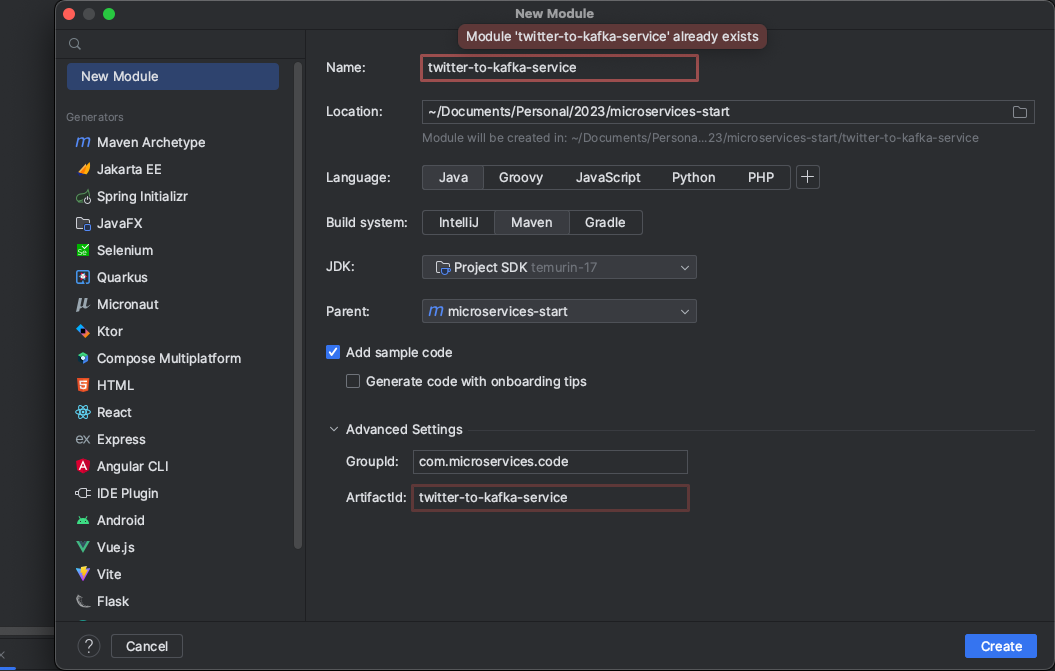Event-driven Spring boot, kafka and elastic
SER.1. How to Create Multi-Project Maven POMs
This is a simple example of how to use spring boot, kafka and elastic to create a simple event-driven application.
Objectives
Our objective is to create a setup POM for our microservices. We will create a parent POM that will be used to manage the versions of the dependencies and plugins used in the microservices.
We will also create a POM for each microservice that will inherit from the parent POM.
SER.1.1. Create a parent POM
Our parent POM does not contain any code. It is used to manage the versions of the dependencies and plugins used in the microservices.
So, It is a POM and not a war or jar package. Which implies we would use it as a base POM for our microservices.
<packaging>pom</packaging>Our parent POM will inherit from the spring-boot-starter-parent POM. This POM contains the versions of the dependencies and plugins used in the spring boot applications.
<parent>
<groupId>org.springframework.boot</groupId>
<artifactId>spring-boot-starter-parent</artifactId>
<version>3.0.5</version>
<relativePath/> <!-- lookup parent from repository -->
</parent>SER.1.2. Dependency Management
This helps define some base dependencies that will be used in the microservices. We can also define the version of the dependencies here.
<dependencyManagement>
<dependencies>
<dependency>
<groupId>org.springframework.boot</groupId>
<artifactId>spring-boot-starter</artifactId>
<version>${spring-boot.version}</version>
</dependency>
<dependency>
<groupId>org.springframework.boot</groupId>
<artifactId>spring-boot-starter-test</artifactId>
<scope>test</scope>
</dependency>
</dependencies>
</dependencyManagement>SER.1.3. Build Management
Our Build Management contains a section pluginManagement. All the plugins and submodules can use the plugins defined in this section.
Without specifying versions.Additionally, we define a maven compiler plugin to use the java.version property defined in the properties section.
This is inherited by all the microservices. and the compiler plugin will be set to the value of the <java.version> property.
Note, after java 9, we can use the release tag to specify the java version.
<build>
<plugins>
<plugin>
<groupId>org.apache.maven.plugins</groupId>
<artifactId>maven-compiler-plugin</artifactId>
<version>${maven-compiler-plugin.version}</version>
<configuration>
<release> ${java.version} </release>
</configuration>
</plugin>
</plugins>
<pluginManagement>
<plugins>
<plugin>
<groupId>org.springframework.boot</groupId>
<artifactId>spring-boot-maven-plugin</artifactId>
<version>${spring-boot.version}</version>
</plugin>
</plugins>
</pluginManagement>
</build>SER.1.4. Properties
Notice the notion of properties in the parent POM. We can define properties in the parent POM and use them in the microservices.
It is a good practice to define the versions of the dependencies and plugins in the parent POM and use them in the microservices.
<properties>
<java.version>17</java.version>
<spring-boot.version>3.0.5</spring-boot.version>
<maven-compiler-plugin.version>3.8.0</maven-compiler-plugin.version>
</properties>SER.1.5. SUBMODULE CREATION (twitter-to-kafka-service)
If we click and select from the context menu, we will see a dialog. We can select the module type and click .

WHAT OUR PARENT POM LOOKS LIKE NOW
Our parent module generates a tag to keep submodules inherating from it. We can add the twitter-to-kafka-service module to the tag.
<modules>
<module>twitter-to-kafka-service</module>
</modules>SER.1.6. What our twitter-to-kafka-service(Submodule) POM looks like
It inherits from the parent POM and contains the dependencies and plugins used in the microservice.
Notice the parent of this submodule is our parent POM and not the spring-boot-starter-parent POM.
<?xml version="1.0" encoding="UTF-8"?>
<project
xmlns="http://maven.apache.org/POM/4.0.0"
xmlns:xsi="http://www.w3.org/2001/XMLSchema-instance"
xsi:schemaLocation="http://maven.apache.org/POM/4.0.0 http://maven.apache.org/xsd/maven-4.0.0.xsd">
<modelVersion>4.0.0</modelVersion>
<parent>
<groupId>com.microservices.code</groupId>
<artifactId>microservices-start</artifactId>
<version>0.0.1-SNAPSHOT</version>
</parent>
<artifactId>twitter-to-kafka-service</artifactId>
<properties>
<project.build.sourceEncoding>UTF-8</project.build.sourceEncoding>
</properties>
<dependencies>
<dependency>
<groupId>org.springframework.boot</groupId>
<artifactId>spring-boot-starter</artifactId>
</dependency>
<dependency>
<groupId>org.springframework.boot</groupId>
<artifactId>spring-boot-starter-test</artifactId>
<scope>test</scope>
</dependency>
<dependency>
<groupId>org.twitter4j</groupId>
<artifactId>twitter4j-stream</artifactId>
</dependency>
<dependency>
<groupId>org.projectlombok</groupId>
<artifactId>lombok</artifactId>
<scope>provided</scope>
</dependency>
</dependencies>
<build>
<plugins>
<plugin>
<groupId>org.springframework.boot</groupId>
<artifactId>spring-boot-maven-plugin</artifactId>
</plugin>
</plugins>
</build>
</project>Summary
All subsequent microservices will look like the twitter-to-kafka-service module. The only difference is the artifactId and the dependencies and plugins used in the microservice.
Notice we have not defined the version of the dependencies and plugins. We will use the version defined in the parent POM by default.
In the section above, our goal was to see how we can define a parent POM that will be used to manage the versions of the dependencies and plugins used in the microservices.
'Spring Boot' 카테고리의 다른 글
| TESTCONTIANERS (0) | 2023.05.04 |
|---|---|
| How to trigger Mono execution after another Mono terminates (0) | 2023.03.09 |
| What is Spring Mobile Device (0) | 2022.11.07 |